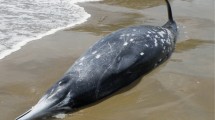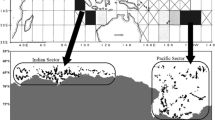Abstract
For many years, researchers have speculatedthat fin whales are year-round residents in theSea of Cortez (= Gulf of California). Previouswork by Bérubé and co-workers has shownthat the degree of genetic diversity among finwhales in the Sea of Cortez at nuclear andmitochondrial loci is highly reduced. However,the relatively unobstructed connection with theNorth Pacific Ocean argues that Sea of Cortezfin whales are part of a much larger easternNorth Pacific population given the extensivemigratory ranges observed in fin whales andbaleen whales in general. The low degree ofgenetic variation might thus simply be due tohistoric fluctuations in the effectivepopulation size of an eastern North Pacificpopulation. In order to test if the reducedgenetic variation detected among fin whales inthe Sea of Cortez is due to small populationsize or a past bottleneck in an otherwise largeeastern North Pacific population, we analyzedthe geographic distribution of geneticvariation at a single mitochondrial (controlregion) and 16 nuclear loci in samplescollected from fin whales in the eastern NorthPacific (n = 12) as well as the Sea of Cortez(n = 77). Our results showed that fin whalesobserved in the Sea of Cortez constitute ahighly isolated and thus evolutionary uniquepopulation, which warrants special conservationmeasures given the current low estimate ofabundance of approximately 400 individuals.
Similar content being viewed by others
References
Baker CS, Medrano-Gonzalez L, Calambokidis J, Perry A, Pichler F, Rosenbaum H, Straley JM, Urban-Ramirez J, Yamaguchi M, Von Ziegesar O (1998) Population structure of nuclear and mitochondrial DNA variation among humpback whales in the North Pacific. Molecular Ecology, 7, 695–707.
Baker CS, Patenaude NJ, Bannister JL, Robins J, Kato H (1999) Distribution and diversity of mtDNA lineages among southern right whales (Eubalaena australis) from Australia and New Zealand. Marine Biology, 134, 1–7.
Baker CS, Perry A, Bannister JL, Weinrich MT, Abernethy RB, Calambodikis J, Lien J, Lambertsen RH, Urban Ramirez J, Vasquez O, Clapham PJ, Alling A, O'Brien SJ, Palumbi SR (1993) Abundant mitochondrial DNA variation and world-wide population structure in humpback whales. Proceedings of the National Academy of Science, USA, 90, 8239–8243.
Baker SC, Slade RW, Bannister JL, Abernethy RB, Weinrich MT, Lien J, Urban J, Corkeron P, Calambodikis J, Vasquez O, Palumbi SR (1994) Hierarchical structure of mitochondrial DNA gene flow among humpback whales Megaptera novaeangliae world-wide. Molecular Ecology, 3, 313–327.
Bakke I, Johansen S, Bakke Ø, El-Gewely MR (1996) Lack of population subdivision among the minke whales (Balaenoptera acutorostrata) from Icelandic and Norwegian waters based on mitochondrial DNA sequences. Marine Biology, 125, 1–9.
Bérubé M, Aguilar A, Dendanto D, Larsen F, Notarbartolo-di-Sciara G, Sears R, Sigurjónsson J, Urban-Ramirez J, Palsbøll PJ (1998) Population genetic structure of North Atlantic, Mediterranean Sea and Sea of Cortez fin whales, Balaenoptera physalus (Linnaeus, 1758): analysis of mitochondrial and nuclear loci. Molecular Ecology, 7, 585–600.
Bérubé M, Jørgensen H, McEwing R, Palsbøll PJ (2000) Polymorphic di-nucleotide microsatellite loci isolated from the humpback whale, Megaptera novaeangliae. Molecular Ecology, 9, 2181–2182.
Bérubé M, Palsbøll PJ (1996a) Erratum of Identification of sex in cetaceans by multiplexing with three ZFX and ZFY specific primers. Molecular Ecology, 5, 602.
Bérubé M, Palsbøll PJ (1996b) Identification of sex in Cetaceans by multiplexing with three ZFX and ZFY specific primers. Molecular Ecology, 5, 283–287.
Bowcock AM, Ruiz-Linares A, Tomfohrde J, Minch E, Kidd JR, Cavalli-Sforza LL (1994) High resolution of human evolutionary trees with polymorphic microsatellites. Nature, 368, 455–457.
Calambokidis J, Steiger GH, Cubbage JC, Balcomb KC, Ewald C, Kruse S, Wells R., Sears R. (1990) Sightings and movements of blue whales off Central California 1986–88 from photoidentification of individuals. Report of the International Whaling Commission Special Issue, 12, 343–348.
Felsenstein J (1993) PHYLIP 3.5c edit. Manual and program available from Joe Felsenstein, University of Washington, WA, Seattle.
Gilmore RM (1957) Whales around in Corte's Sea. Tragic Strandings in the Gulf of California. Pacific Discovery, 10, 22–27.
Hoelzel RA (1994) Genetics and ecology of whales and dolphins. Annual Review of Ecology and Systematics, 25, 377–399.
Kimura M (1980) A simple method for estimating evolutionary rate of base substitutions through comparative studies of nucleotide sequences. Journal of Molecular Evolution, 16, 111–120.
Leatherwood S, Reeves RR, Perrin WF, Evans W (1988) Whales, Dolphins and Porpoises of the Eastern North Pacific and Adjacent Arctic Waters. A Guide to Their Identification. Dover Publications, Inc., New York.
Lyrholm T, Gyllensten U (1998) Global matrilineal population structure in sperm whales as indicated by mitochondrial DNA sequences. Proceedings of the Royal Society, London, Series B., 265, 1679–1684.
Lyrholm T, Leimar O, Johanneson B, Gyllensten U (1999) Sexbiased dispersal in sperm whales: contrasting mitochondrial and nuclear genetic structure of global populations. Proceedings of the Royal Society, London, Series B., 266, 347–354.
Paetkau D, Strobeck C (1994) Microsatellite analysis of genetic variation in black bear populations. Molecular Ecology, 3, 489–495.
Palsbøll PJ, Bérubé M, Larsen AH, Jørgensen H (1997a) Primers for the amplification of tri-and tetramer microsatellite loci in cetaceans. Molecular Ecology, 6, 893–895.
Palsbøll PJ, Heide-Jørgensen MP, Dietz D (1997b) Population structure and seasonal movements of narwhals, Monodon monoceros, determined from mtDNA analysis. Heredity, 78, 284–292.
Rannala B, Mountain JL (1997) Detecting immigration by using multilocus genotypes. Proceedings of the National Academy of Science, USA, 94, 9197–9201.
Raymond M, Rousset F (1995) GENEPOP (Version1.2): population genetics software for exact tests and ecumenicism. Journal of Heredity, 86, 248–249.
Rice WR (1989) Analyzing tables of statistical tests. Evolution, 43, 223–225.
Roff DA, Bentzen P (1989) The statistical analysis of mitochondrial DNA polymorphisms: c2 and the problem of small samples. Molecular Biology and Evolution, 6, 539–545.
Roques S, Duchesne P, Bernatchez L (1999) Potential of microsatellites for individual assignment: the North Atlantic redfish (genus Sebastes) species complex as a case study. Molecular Ecology, 8, 1703–1718.
Rosel PE, Dizon AE, Haygood MG (1995) Variability of the mitochondrial control region in populations of the harbour porpoise, Phocoena phocoena, on interoceanic and regional scales. Canadian Journal of Fisheries and Aquatic Sciences, 52, 1210–1219.
Tershy BR, Urban-R J, Breese D, Rojas-B L, Findley LY (1993) Are fin whales resident to the Gulf of California? Revista de Investigación Científica, 1, 69–72.
Urbán R J (1996) La poblaciná del rorcual comÚn Balaenoptera physalus en el Golfo de California. Final Report to the Comisión Nacional para la Bioversidad CONABIO-B040, 102 pp.
Valsecchi E, Amos W (1996) Microsatellite markers for the study of cetacean populations. Molecular Ecology, 5, 151–156.
Valsecchi E, Palsbøll P, Hale P, Glockner-Ferrari D, Ferrari M, Clapham P, Larsen F, Mattila D, Sears R, Sigurjonsson J, Brown M, Corkeron P, Amos B (1997) Microsatellite genetic distances between oceanic populations of the humpback whale (Megaptera novaeangliae). Molecular Biology and Evolution, 14, 355–362.
Weir BS (1996) Genetic Data Analysis II. Methods for Discrete Population Genetic Data. Sinuaer Associates, Inc. Publishers, Sunderland, Massachusetts.
Author information
Authors and Affiliations
Corresponding author
Rights and permissions
About this article
Cite this article
Bérubé, M., Urbán, J., Dizon, A.E. et al. Genetic identification of a small and highly isolated population of fin whales (Balaenoptera physalus) in the Sea of Cortez, México. Conservation Genetics 3, 183–190 (2002). https://doi.org/10.1023/A:1015224730394
Issue Date:
DOI: https://doi.org/10.1023/A:1015224730394




